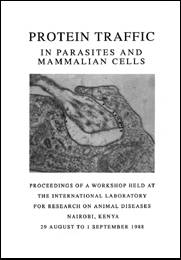
PROCEEDINGS OF A WORKSHOP HELD AT THE INTERNATIONAL LABORATORY FOR RESEARCH ON ANIMAL DISEASES
NAIROBI, KENYA
29 AUGUST TO 1 SEPTEMBER 1988
Endocytosis in trypanosomes occurs via the flagellar pocket. Macromolecules enter the flagellar pocket from the outside of the cell and are then taken up by endocytosis. This picture shows particles of colloidal gold inside the flagellar pocket prior to endocytosis. Magnification: 80,000 ×.
Organized by
The International Laboratory for Research on Animal Diseases
With support from
The United Nations Development Programme
Scientific Editor
J.D. Lonsdale-Eccles
Production Editor
J.K. Lenahan
Published by
THE INTERNATIONAL LABORATORY FOR RESEARCH ON ANIMAL DISEASES
BOX 30709 · NAIROBI · KENYA
|
The International Laboratory for Research on Animal Diseases (ILRAD) was established in 1973 with a mandate to develop effective control measures for livestock diseases that seriously limit world food production. ILRAD's research program focuses on African animal trypanosomiasis and East Coast fever, a form of theileriosis. ILRAD is one of 13 centres in a worldwide agricultural research network sponsored by the Consultative Group on International Agricultural Research. In 1988 funding for essential research and training activities was provided by the African Development Bank, the Rockefeller Foundation, the United Nations Development Programme, the World Bank (the International Bank for Reconstruction and Development) and the governments of Australia, Belgium, Canada, Denmark, France, India, Italy, Japan, the Netherlands, Norway, Sweden, Switzerland, the United Kingdom, the United States of America and West Germany. Additional research activities were supported by special funding arrangements from the European Economic Community and the World Health Organization and capital funds were provided by the Netherlands Government for construction of a new training and outreach building. |
This publication was typeset on a microcomputer and the final pages produced on a laser printer at ILRAD. The printing was done by Majestic Printing Works, Nairobi, Kenya.
© Published in 1989 by the International Laboratory for Research on Animal Diseases.
ISBN 92-9055-290-5
The correct citation for this book is: International Laboratory for Research on Animal Diseases. 1989. Protein Traffic in Parasites and Mammalian Cells: Proceedings of a Workshop Held at the International Laboratory for Research on Animal Diseases, Nairobi, Kenya, 29 August to 1 September 1988. Nairobi: International Laboratory for Research on Animal Diseases.
This electronic document has been scanned using optical character recognition (OCR) software and careful manual recorrection. Even if the quality of digitalisation is high, the FAO declines all responsibility for any discrepancies that may exist between the present document and its original printed version.
Protein Phosphorylation in Trypanosoma brucei
Methods
Results
Discussion
References
Trafficking of Plasmodial Antigens from the Parasite to the Erythrocyte
Erythrocyte Changes Induced by P. falciparum
Movement of the P. falciparum Protein to the Erythrocyte Membrane Resulting in Lysis of the Erythrocyte and Release of Gametes
Erythrocyte Changes Induced by P. brasilianum Infection
Erythrocyte Changes Induced by P. vivax
Conclusions
References
Phagosome-Lysosome Membrane Traffic in Paramecium
Membranes Belonging to the Phagosome-Lysosome System
Characteristics of the Cytopharynx and Nascent Phagosome Membrane
Evidence for in Situ Membrane Modification
Fates of the Different Pools of Membrane Incorporated into the Membrane of Phagosomes or Phagolysosomes
Discussion and Conclusions
References
The Link between Clathrin-Coated Pits and Receptor Mediated Endocytosis
Inhibitors of Coated Pit Function
Reconstitution of the Endocytic Cycle in Vitro
Future Directions
References
Cysteine Endopeptidases and Their Inhibitors in Tissue Invasion
Cathepsin L
Histolysin
Inhibitors of Cysteine Proteinases
References
Weak Bases as Inhibitors of the Trypanocidal Activity of Human Serum
Effects of Weak Bases on the Trypanolytic Action
Characteristics of the Trypanolytic Factor
Conclusions
References
Trypanosomiasis: Host Susceptibility and Trypanosoma brucei Lipid Uptake
References
Free Radicals and Protein Damage: Consequence for Protein Function and Catabolism, and in Cytolysis
References
References
Control of Intracellular Digestion in Paramecium
Results
Summary
Acknowledgements
References
ATP-Requiring Proteolytic Pathways in Bacterial and Mammalian Cells
Protease La
The Heat-Shock Response and Protein Breakdown
Other ATP-Hydrolyzing Proteases
The Proteolytic Complexes in Mammalian Cells
Prospects
Selected Reading
Methods
Results and Discussion
References
Understanding Human Lysosomal Diseases: A Review
Cytoplasmic delivery of proteins and DNA by pH-sensitive liposomes
Mechanism of delivery
Delivery of plasmid DNA in vitro
Delivery of plasmid DNA in vivo
Conclusions
References
Protein Secretion in endocrine tumor cells
Sorting of proteoglycans into secretory granules
Conclusion
References
Proteolysis and endocytosis in Trypanosoma brucei
Materials and Methods
Results
Discussion
References
Mechanisms for sorting ligands and receptors following endocytosis
pH of endosomal compartments
Vesicle fusion and separation on the endocytic pathway
References
Acknowledgement
References
Formation of disulphide linked oligomers of the HN glycoprotein of Newcastle disease virus
Intermolecular disulphide bonds form intracellularly
Oligomer formation and intracellular transport
Expression of the HN protein using a retroviral vector
Disulphide-linked oligomer formation early in infection
Conclusions
References
Protein kinase activation in Theileria-infected cells
Protein kinase activation in Theileria-infected cells
Conclusions
References
Assembly and intracellular transport of a multichain protein: human fibrinogen
Early studies
Intracellular forms of fibrinogen
Order of chain assembly
Enzymatic mechanism of chain assembly
Secretion of nascent fibrinogen
References
Synthetic inactivators of serine and cysteinyl proteases for biological application
Use of protease specificity for inhibitor structure
Peptidyl fluoromethyl ketones
Peptidyl diazomethyl ketones
Peptidylmethyl sulphonium salts
Summary
References
Defining apical sorting in epithelial cells
References
Sorting of membrane proteins in the endosomal compartment of hepatocytes
References
Endocytosis by African trypanosomes
Transferrin binding
Cell association of transferrin at 37 °C
Cell association of 59Fe-transferrin
Transferrin-gold binding and uptake
Uptake of bovine serum albumin and transferrin coupled to gold
Binding and uptake of horseradish peroxidase (HRP)
Uptake of HRP and transferrin-gold
Conclusions
References